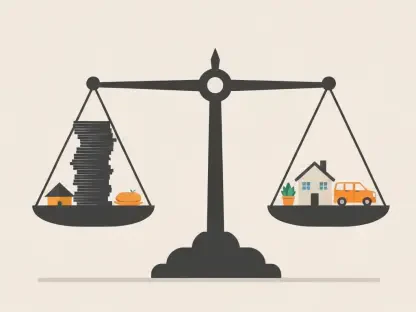Bank of America (NYSE: BAC) stands as one of the most prominent financial institutions in the United States, with a rich history of resilience and adaptability. From its Depression-era roots in San Francisco, it has grown to become the second-largest bank in the US by asset size, trailing only JP Morgan Chase. This article delves into the financial trajectory, strategic initiatives, and future projections of Bank of America, exploring whether it can overcome its current challenges to achieve sustained growth.
Business Focus and Strategy
Strategic Shift Post-2008 Financial Meltdown
Since the 2008 financial crisis, Bank of America has pivoted towards growing assets under management (AUM). This strategic shift was significantly bolstered by its acquisition of Merrill Lynch, enhancing its wealth management division. CEO Brian Moynihan has streamlined operations, focusing on asset growth with minimal overhead, steering the company towards a more sustainable and profitable future. The emphasis on efficiency and cost-reduction has enabled the bank to reallocate resources towards core growth areas, particularly in wealth management and technological advancements.
Additionally, the bank’s forward-thinking approach encompasses diversifying income streams and strengthening its risk management frameworks. This multifaceted strategy aims to shield the institution from potential financial shocks and ensure long-term vitality. Integrating Merrill Lynch into its framework has had a transformative impact on the bank, significantly amplifying its capacity to offer comprehensive financial advisory services.
Emphasis on Wealth Management
The acquisition of Merrill Lynch has been a cornerstone of Bank of America’s strategy to expand its wealth management services. This move has allowed the bank to cater to high-net-worth clients, contributing substantially to overall profits. The focus on wealth management is expected to be a significant revenue driver in the coming years, aligning with the bank’s long-term growth objectives. High-net-worth individuals seek bespoke solutions for their financial needs, and Bank of America positions itself as a leading provider in this highly lucrative segment.
Bank of America’s wealth management arm benefits not only from the inherited expertise of Merrill Lynch but also from integrated technologies that enhance client experience and operational efficiency. The bank employs AI-driven insights and advanced analytics to provide personalized financial advice and investment strategies. This technological enhancement empowers advisors to deliver high-quality service, tailored to the unique preferences and goals of each client.
Key Challenges and Headwinds
Insider Sales and Leadership Changes
Bank of America faces several significant challenges, including insider sales and leadership changes. Notably, Warren Buffett, a long-time major shareholder, sold $6 billion worth of BAC shares in July 2024, signaling potential concerns about the bank’s short-term prospects. The move by such an influential investor has undoubtedly raised eyebrows and sparked discussions about the bank’s future direction. Moreover, the departures of key executives like Bernard Mensah, President of the international division, and Ken Leung, co-head of the financial sponsors group in Asia Pacific, have amplified uncertainty within the ranks of Bank of America’s leadership.
These executive departures may pose challenges in maintaining continuity and driving strategic initiatives forward. Leadership stability is crucial in navigating the complexities of financial markets, especially when the institution is going through significant transitions. The bank’s management must reassure stakeholders that despite these high-profile exits, continuity and strategic vision remain intact, and these gaps will be filled with equally capable leaders who can steer the institution towards its goals.
Regulatory Hurdles and Economic Conditions
Regulatory hurdles, such as Basel III international banking regulations, demand higher retained capital levels, complicating the bank’s outlook. These regulations aim to prevent another financial crisis similar to the 2008 meltdown, requiring compliance by October 2024. High-interest rates, driven by escalating inflation and subsequent Fed Funds rate hikes, have made lending and mortgage businesses prohibitively expensive for many customers, undercutting Bank of America’s core lines of business.
The regulatory landscape for banking institutions is becoming increasingly stringent, necessitating robust compliance mechanisms and risk mitigation strategies. These new capital requirements, while designed to safeguard financial stability, impose additional burdens on banks like Bank of America, which must balance regulatory compliance with profitability. CEO Brian Moynihan’s contestation with the Treasury Department and the Federal Reserve over the Basel III requirements underscores the tension between regulatory demands and operational flexibility.
Technology and Digital Strategy
Investment in Technological Advancements
Despite these challenges, Bank of America is heavily investing in technological advancements. Digital payments, AI-enhanced customer service, and the development of the Erica platform, a virtual financial assistant, are pivotal components of its strategy. These tools aim to improve customer experience and bolster operational efficiency by cutting costs. Advanced AI technologies streamline operations and provide personalized experiences for customers, ultimately enhancing satisfaction and brand loyalty.
The Erica platform, in particular, represents a significant leap in the digital transformation journey. Providing a comprehensive suite of financial management tools, Erica offers clients seamless interactions, from tracking expenses to making investments on-the-go. The bank’s strategy emphasizes integrating such technologies to future-proof its business model against rapidly evolving financial landscapes and customer expectations.
Expansion of Digital and Physical Presence
The bank’s digital transformation is also evident in its efforts to expand its physical and digital presence across the US. By integrating digital tools and AI-driven customer service enhancements, Bank of America aims to improve customer satisfaction and operational efficiency, positioning itself as a leader in the digital banking space. The simultaneous expansion of physical branches seeks to maintain a substantial on-ground presence, catering to customers who prefer personal interactions.
Moreover, the dual strategy of enhancing digital capabilities while broadening the physical branch network acknowledges the diverse preferences of the customer base. Physical branches offer bespoke financial consultations and relationship management, complementing the efficiency and convenience of digital banking solutions. This holistic approach aims to maximize outreach and ensure all demographics find value in the bank’s offerings.
Financial Performance and Future Projections
Stock Performance and Market Sentiment
Bank of America’s stock performance has been volatile over the past decade. After peaking at $50 per share in 2022, the bank has struggled to reach those heights again. Recent stock price updates note fluctuations influenced by various factors, including insider sales and market sentiment. For instance, the acquisition of multifamily commercial real estate loans from HomeStreet Bank and the decrease in short interest in November 2024 reflect the bank’s ongoing efforts to stabilize and grow its financial standing.
The market’s perception of Bank of America is shaped by its ability to adapt to changing economic conditions and investor actions. The impact of large-scale insider sales, stock ratings, and economic indicators contribute significantly to the stock’s volatility. Shareholders and analysts alike closely scrutinize these factors, assessing the bank’s resilience and forecasting future performance. Despite recent challenges, the continuation of strategic acquisitions and investor confidence in management’s growth agenda remain pivotal in influencing market sentiment.
Analyst Ratings and Future Price Targets
Analyst ratings and future price targets provide insights into the bank’s potential growth. Morgan Stanley’s recent downgrade from “overweight” to “equal weight” but raised price target from $48.00 to $55.00 indicates cautious optimism. Wall Street analysts project a $46.00 price target for 2025, with a mixed outlook for the following years, suggesting moderate growth driven by successful implementation of strategic initiatives.
These ratings and projections reflect varied assessments of the bank’s financial health and execution effectiveness. On one hand, analysts appreciate the bank’s robust capital position and strategic focus on profitable ventures like wealth management. On the other, concerns about regulatory compliance, economic pressures, and market competition temper optimistic projections. Consequently, stakeholders must weigh these factors carefully when considering investment decisions.
Strategic Initiatives and Capital Deployment
Interest Sensitive Balance Sheet
Bank of America’s net interest income (NII) has benefitted from the Fed’s rate hikes, but these benefits are counterweighed by higher default rates and reduced transaction volumes. The bank’s interest-sensitive balance sheet remains a critical factor in its financial performance, influencing its ability to generate revenue in a high-interest-rate environment. As borrowers face tighter financial conditions, the bank must navigate these complexities to maintain profitability.
To sustain earnings and mitigate risks, Bank of America employs diversified income strategies. While interest income remains crucial, expanding into fee-based services, wealth management, and investment banking helps balance its portfolio. This mix allows the bank to cushion itself against market volatilities, ensuring a stable revenue stream even under challenging economic scenarios.
Branch Expansion and Capital Strategies
The bank’s growth strategy incorporates expanding financial centers and branches to enhance its local presence across the US. Investments in digital tools and AI-driven customer service enhancements are expected to improve customer satisfaction and operational efficiency. Additionally, dividend increases and share repurchase plans underline the bank’s strong capital position, appealing to dividend-focused investors. This multi-faceted approach aims to bolster both customer trust and shareholder value.
By strategically opening new branches, Bank of America aims to penetrate underserved markets and broaden its customer base. These physical expansions are complemented by digital innovations, ensuring the bank offers integrated services that combine convenience and personal touch. Capital strategies like dividends and share buybacks provide returns to investors and reflect confidence in the bank’s financial strength, fostering loyalty and enhancing market reputation.
Wealth Management and Off-Balance Sheet Assets
Global Wealth Division as a Revenue Driver
The Global Wealth Division is expected to be a significant revenue driver, with high-net-worth clients contributing substantially to overall profits. The bank’s strategy of accumulating AUM is poised to bolster its financial standing, aligning with its long-term growth objectives. High-net-worth clients seek tailored financial solutions, and the Global Wealth Division positions itself to meet these requirements with a range of bespoke services.
Bank of America’s focus on wealth management leverages advanced technologies and personalized support systems to deliver superior client experiences. By deploying AI and big data analytics, the bank offers clients nuanced insights and strategies prepared specifically for their financial goals. This technological edge, coupled with deep financial expertise, ensures the Global Wealth Division is a formidable pillar in the bank’s revenue framework.
Off-Balance Sheet Risks and Strategic Management
However, there are concerns about the $1.6 trillion in off-balance sheet assets, including Letters of Credit and derivatives, which could pose significant risks if not managed properly. Effective risk management strategies are crucial to mitigate potential adverse impacts on the bank’s financial stability. The complexity and sheer volume of these off-balance sheet items necessitate stringent oversight and rigorous management practices.
Bank of America’s strategy involves deploying robust risk management systems and maintaining transparency in reporting these assets. Employing a comprehensive approach that includes stress testing, scenario analysis, and risk-adjusted return assessments helps the bank anticipate and navigate potential pitfalls. Effectively managing these off-balance sheet assets is vital for sustaining confidence among stakeholders and ensuring long-term financial health.
Conclusion
Bank of America (NYSE: BAC) is one of the leading financial institutions in the United States, boasting a significant presence and a storied history of resilience and adaptability. Originating during the Great Depression in San Francisco, it has grown impressively to hold the position of the second-largest bank in the U.S. by asset size, coming in just behind JP Morgan Chase.
This rich history and substantial growth speak to Bank of America’s ability to navigate various economic landscapes and challenges over the years. Despite the financial crises and market fluctuations that have occurred, the bank has continuously evolved, demonstrating its strength and strategic foresight.
The article aims to explore the financial trajectory of Bank of America, focusing on its strategic initiatives that have propelled it forward, such as its investments in technology and customer service enhancements. Through innovation and customer-focused strategies, Bank of America has sought to modernize its offerings and improve operational efficiencies.
Additionally, the discussion will touch on the bank’s future projections, considering current challenges such as regulatory scrutiny, market competition, and economic uncertainties. The analysis will provide insights into whether Bank of America can maintain its growth momentum in the face of these hurdles and continue to expand its market footprint while offering valuable services to its customers.









